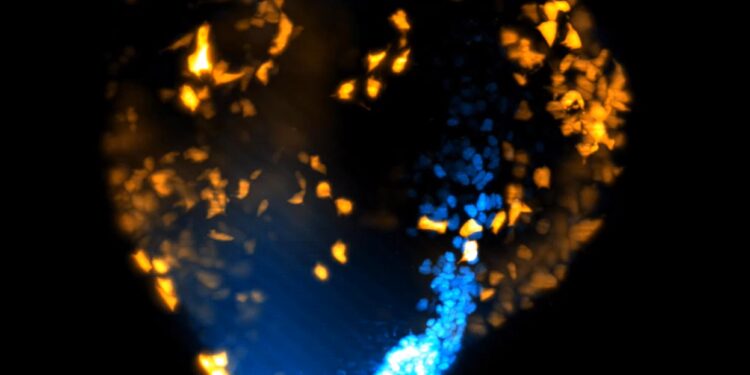Credit: Shayma Abukar et al
The researchers of the UCL and the Francis Crick Institute, for the first time, identified the origin of the cardiac cells using 3D images of a heart forming in real time, within a living mouse embryo.
For the study, published in The Journal Embo, The team used a technique called advanced microscopy with light sheets on a specially designed mouse model. This is a method where a thin sheet of light is used to light up and take detailed images of tiny samples, creating light 3D images without damaging living tissues.
In doing so, they were able to follow individual cells as they moved and divided over two days – from a stage of critical development known as gastrulation to the point where the primitive heart begins to take shape. This allowed researchers to identify the cellular origins of the heart.
Gastrulation is the process by which cells begin to specialize and organize in the primary structures of the body, including the heart. In humans, this happens during the second week of pregnancy.
The results of the study could revolutionize the way scientists include and treat congenital heart malformations, according to researchers.
The main author, Dr. Kenzo Ivanovitch (UCL Great Ormond Street Institute of Child Health and British Heart Foundation Intermediate Research Fellow) said: “This is the first time that we have been able to watch the heart cells as closely, during this long period during the long periods, from a few hours to a few days, and what we had noticed was completely unexpected in A dish. “
Using fluorescent markers, the team marked cardiac muscle cells (called cardiomyocytes), which made them shine in distinct colors. Combined with light -leaf microscopy, this innovation has enabled researchers to create a detailed accelerated video.
The snapshots were captured every two minutes over 40 hours, producing images with unprecedented spatial resolution.
The resulting images have shown how cells move, divide and form the first parts of an embryo, like the heart. Each brilliant cardiomyocyte could then be found in anterior cells, allowing scientists to create a genealogical tree of cells. This helped them see exactly when and where the first cells that make the heart appear in the embryo.
In the early stages, embryonic cells were multiple (capable of becoming different types of cells). These included not only cardiac cells but also others such as endocardial cells, a type of cell that lines the interior surfaces of blood vessels and heart chambers.
However, the researchers found that early during gastrulation (generally in the first four to five hours, after the first cell division), the cells contributing only to the heart emerge quickly and behave very organized.
Rather than moving at random, they follow distinct paths – almost as if they already knew where they are going and what role they will play, that they contribute to the ventricles (the pumping rooms of the heart) or the earrings (where the blood penetrates the heart of the body and the lungs).
Dr. Ivanovitch said: “Our results demonstrate that determining heart fate and the movement of directional cells can be regulated much earlier in the embryo than current models suggest.
“This fundamentally changes our understanding of cardiac development by showing that what seems to be the migration of chaotic cells is actually governed by hidden models which ensure good heart formation.”
Principal author, Ph.D. The candidate Shayma Abukar (UCL Great Ormond Street Institute of Child Health and UCL Institute for Cardiovascular Science) said: “We are now working to understand the signals that coordinate this complex choreography of cellular movements at the start of heart development.
“The heart does not come from a single group of cells, it is formed from a coalition of distinct cellular groups which appear at different times and places during gastrulation.”
The ideas of study could revolutionize the way scientists include and treat congenital heart malformations, which affect almost one in 100 baby. The results could also speed up progress in the growth of laboratory tissue in laboratory for regenerative medicine.
Dr. Ivanovitch said: “In the future, we hope that this work will help discover new organ training mechanisms.
More information:
Shayma Abukar et al, early coordination of cell migration and the determination of heart fate during the gastrulation of mammals, The Journal Embo (2025). DOI: 10.1038 / S44318-025-00441-0
Supplied by University College London
Quote: Scientists film the heart which forming in 3rd earlier than ever (2025, May 13) recovered on May 13, 2025 from
This document is subject to copyright. In addition to any fair program for private or research purposes, no part can be reproduced without written authorization. The content is provided only for information purposes.



